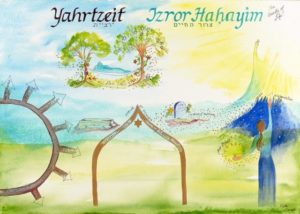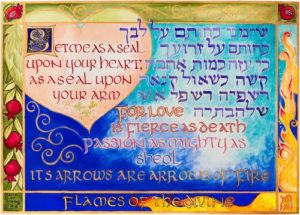Today, SevenPonds speaks with Rabbi Me’irah, a San Francisco-based rabbi and visual artist. After earning a master’s degree in social work from Portland State University, Rabbi Me’irah spent 15 years in the field. Along the way, she reconnected with her spirituality and enrolled in rabbinical college with the goal of becoming ordained. She became one of the first graduates of the Gamliel Institute, an organization that teaches Jewish end-of-life care traditions (called Hevra Kadisha). She teaches at Jewish community and assisted living centers, as well as from her personal rabbinate, Verses Illuminated.
 Marissa: Thank you for joining us, Rabbi Me’irah! Have you always wanted to be a rabbi, or was this an unexpected career?
Marissa: Thank you for joining us, Rabbi Me’irah! Have you always wanted to be a rabbi, or was this an unexpected career?
Rabbi Me’irah: I grew up with a Jewish mother who had next to no Jewish education herself. Consequently, my own Jewish education as a child was nearly non-existent. I knew I was Jewish, but I had a certain shame for not knowing anything about it. But bit by bit, I learned things. I eventually joined a synagogue in Portland, Oregon, and learning became the most rewarding part of my life. I had what we call an “adult bat mitzvah,” which is somewhat of a misnomer. And after that, I wanted more. Eight years later, I entered the preparatory program for rabbinical school, a journey that took me seven more years. I loved every minute.
Marissa: What do you do as a rabbi?
Rabbi Me’irah: While I am not a congregational rabbi, I enjoy, part time, many of the most delightful aspects of that work. I teach and I lead services at Rhoda Goldman Plaza and do holiday programming there. I am a very active member of Or Shalom Jewish Community in San Francisco. And I have been a substitute there for my rabbi, Katie Mizrahi, while she had her children and was on sabbatical. I have done teaching with the Gamliel Institute and will be doing so again at their annual conference here in San Rafael on June 18 through June 21.
Marissa: Speaking of the Gamliel Institute, you have expertise in Jewish funeral traditions. What can Judaism teach us about the death and dying process?

A painting by Rabbi Me’irah. It is the final piece of a four-part series depicting Jewish mourning traditions. Here, she paints the end of the first year of mourning.
Rabbi Me’irah: Judaism can teach us so much. It is an ancient tradition and has honed the care of the dying and mourners throughout millennia. First and foremost, it teaches us to be calm around death, dying and mourning — neither to be so anxious as to hasten, nor so clinging to unreality as to delay death. It teaches us that in the face of death it is appropriate to stop all other activity, feel our feelings and attend to our grief.
Jewish funeral traditions also teach us that a person in mourning must be surrounded by community, and give us ways to care for the mourner. They also give us many rituals, both at a funeral and in the seven-day shiva, a full mourning period right after the death, that are sources of comfort and healing. Lastly, Judaism reminds us that grieving develops over time and gives us a way to mark those time periods.
Marissa: One of these Jewish funeral traditions is the Taharah. How does it work?
Rabbi Me’irah: I wrote a whole play about how the ritual works! Technically, it is the ritual washing of the body and clothing it in white garments similar to those that the High Priest wore in the temple in Jerusalem in ancient days. Why? Because the High Priest had an appointment once per year, on Yom Kippur, to meet God to ask for forgiveness for the whole community.
We say many verses from our sacred texts during the ritual: verses from the song of songs saying how beautiful the deceased is as we wash her body and prayers for protection and guidance of the soul. We behave as though she is alive, and we experience her soul and God as present in the Taharah room. All of this is done with immense respect for her dignity.
At the close of the ritual, we ask for forgiveness if we have done anything to embarrass her. We lift her gently and place her in the coffin, and close the lid. We are the last to see her. Someone stays with the coffin until burial, which is usually the next morning if the Taharah is done in the evening, or the same day if it is done in the morning. The ritual works to respect the body, the vessel of the soul, to accompany the soul and ask the angels to protect her. It works to comfort the family. And it works mightily on the Taharah workers, helping them to face death and appreciate life.

Another painting by Rabbi Me’irah, illustrating a verse from Song of Songs 8:6.
Marissa: How does the Taharah help families after the death of a loved one?
Rabbi Me’irah: In general, the family knows that with a Jewish death and burial, the body is never left alone. People stay with it, saying psalms. The family knows that the Taharah team acts with utmost care and respect. And they do something that the family is usually too filled with grief to do it themselves. Although there is a movement to do home Taharahs now. And actually, my sisters, nieces and I did it for my mother.
Marissa: What do Jewish traditions say about the afterlife?
Rabbi Me’irah: I would say that the “traditions” say many things about the afterlife. First, there is no monolithic dogma. Yet, there are many varying strands of tradition. The first thing is that so far, we don’t know of anyone who has come back after death to tell us about it. There is a belief in an afterlife. However, we emphasize that what we do know is this life. And it is imperative that we do our part in contributing in a positive way while we are alive.
There are also traditions about the soul: searching for its place right after death, going back and forth between the home and the cemetery. This is a period to contemplate what it did while alive and to face its regrets. When the soul completes this work, it goes to the Garden of Eden for a time. Eventually, it joins the “tzror ha Hayyim,” the bundle of life…or as I put it, “The Great Life Force.”
Join us next week for Part Two of our chat with Rabbi Me’irah, where she discusses the Jewish funeral traditions that she finds most helpful for families.

 How Can Jewish Funeral Traditions Help Families Cope with Grief?
How Can Jewish Funeral Traditions Help Families Cope with Grief?


 “As Tears Go By” by Marianne Faithfull
“As Tears Go By” by Marianne Faithfull

 Funeral Favors Offer Visitors a Tangible Memento
Funeral Favors Offer Visitors a Tangible Memento















